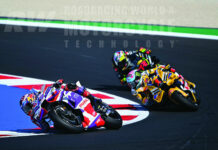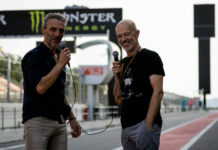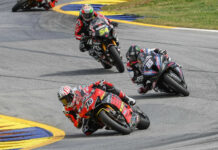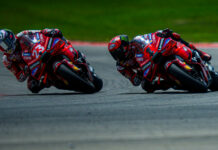From a press release issued by Pramac Honda:
Casole d’Elsa (Siena, Italy)
Tuesday 10 June 2003
Eleven questions for Mr. Hiroshi Yamada, Motorcycle Racing Manager of Bridgestone Corporation
1) Mr. Yamada, Makoto Tamada got an impressive result last Sunday at Mugello, making fourth place in the Italian Grand Prix. Were you expecting he’d do so well?
R) In all honesty, I must say it was an unexpected result, in view of all the variables of Mugello. Tamada had never seen in the circuit until last weekend, and Mugello is a difficult track for anyone when it comes to choosing the tyres and guessing the ground temperature (which can be very high) and indeed it was much higher than we were expecting. On top of all this there was the fact that Makoto Tamada really whipped our products into shape in his extraordinary comeback from eighteenth place to fourth. It must be said it was worth the suspense: we really had no time to prepare for the race on Sunday but with two hours on Friday and two on Saturday we managed to scrape together enough information to get things going.
2) Bridgestone: your workgroup seems to be gaining incredible ground – you’ve never stopped since January. You should be pretty highly motivated by now.
R) You’re right: this result has galvanised the whole team. It’s a new boost not just for us on the MotoGP, but for all those at “home” who’ve made this whole project possible. In other words, I really mean the whole company. I think this result just goes to show that what we’ve been doing so far is really not too far off the mark.
3) Are you talking about the glorious Formula One group too?
R) Sure, we’re in constant contact and our F1 colleagues and technicians are sharing their know-how with us.
4) Do you think a great performance like this could reduce development time?
R) This is a long-term project and we’ve already been able to give an idea of our ambitious projects: for the moment, we’d just like to win a few races in 2004 and we’re aiming for the championship in 2005. As far as this season is concerned, we decided on a hypothetical date by which we thought we ought to be able to achieve some tangible results. We were thinking of the late summer of this year but I believe we’ve just got there a little bit earlier. This is going to give a great boost to our development team, even though we need to keep our wits about us and continue working to schedule. It must be said, though, that last Sunday’s result obviously makes us that much more excited about the whole thing.
5) Let’s try and look at an important factor: the former RC211V is the bike that won the 2002 world championship, and thus the best choice in terms of performance. The rider could well be a variable: he’s on his first time round in the MotoGP and on the tough tracks of the world championship. If you look at his latest performance, Makoto appears to be a rider of extraordinary talent. All this should make developing the tyres that much easier.
R) When we decided to work with Tamada we knew he was going to be the right rider, both for his potential and for his skill. The only thing we weren’t sure about was his total lack of experience on the world championship circuits. His character and his style made us quite sure, however, that he’d learn fast. And he certainly has done. Jerez and Mugello showed we were right. So we’re quite sure about the bike and the rider, and this means we’ve been able to concentrate entirely on what we are most interested in: developing our tyres.
6) We’ve seen that your materials have proved to be excellent in almost extreme conditions – in other words, really high ground temperatures – but soon we’re going to be coming up against the North European rounds where the temperatures aren’t going to be anything like as high.
R) We are quite sure about the work we’ve done so far and I’ve no reason to think we’re going to be less competitive than we have been. We’ve been studying special materials for a pretty broad range of temperatures.
7) Can you give us an idea of the key points? What you are going to have to do to develop the racing products?
R) First of all we can say that the most important thing is to study the ideal compounds for the MotoGP, since the power that the latest engines can release is enormous and it certainly puts the tyres under stress during a race. The quality of the compounds is thus a key element in being competitive rate in terms of fast lap times and in terms of endurance. If, on the other hand, we look at the various steps it takes to create a racing product and absolute top performance, we can say that the shape and profile of the tyre are the first aspects we need to look at in our development work. And then there is more to follow: the construction of the tyre and the composition of the compound. But this is pure “theory” or work method, because then we have to look at the balance between the front and rear tyre on the machine when it’s out on the track, and this is another crucial aspect. Just to give a simple example: at the moment, we’re making good progress in developing the rear tyres, but we’ve also got to keep up the momentum for the front tyres as well. This is essential if we’re to maintain the same balance of the bike and improve its level of performance.
8) Was the result at Mugello the result of some particular tyre?
R) One tyre in particular – the one we used yesterday – had everything a tyre needs to have in order to be competitive in a race. If we want to go into detail, we could say that its profile improves both control and handling while making a good front and rear balance of the bike.
9) What compounds were used at Mugello?
R) A medium-hard front with a hard rear.
10) Could you give us an idea – some actual figure – for the number of different technical solutions you’ve created and tried out on track since the beginning of the year for the MotoGP?
R) We’ve tried out pretty close to 100, I’d say, during the test sessions and during the races this year with our riders.
11) Let’s enter a more sensitive area. Could you tell us about the time it actually takes to create a tyre, or rather how long it takes to make new materials for the MotoGP?
R) It’s possible to make a tyre from scratch in about two to four weeks, while it doesn’t take longer than one to actually construct it. So a totally new compound will take two to three weeks, or much less if it’s an upgrade of an existing formula.
Mr. Yamada, thank you very much indeed.
What About Those MotoGP Bridgestones?
What About Those MotoGP Bridgestones?
© 2003, Roadracing World Publishing, Inc.






